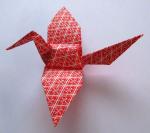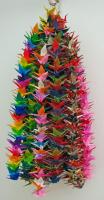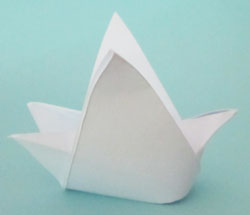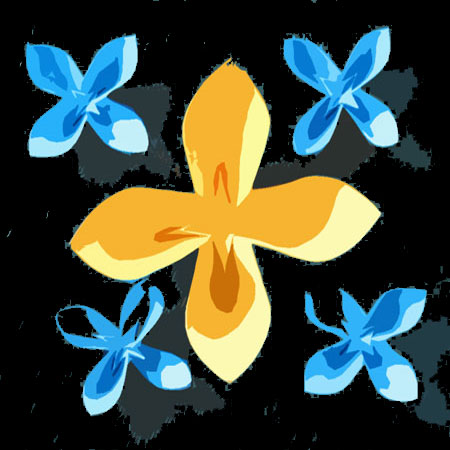Japanese versus Western folding. Neo-tsuru: The parallel-folded crane
The Japanese method
Briefly to repeat my insights about the traditional Japanese origami:
- It is made of squares of duo paper with a superior and inferior side, so that the art is to conceal the inferior underside under the decorated surface.
- This promotes the folding of bases to double the square at once.
- And also the method of progressive fold to a state of locking
- And the classic examples of this approach result in inflatable models capturing a bubbel of air in the middle of the square.
- Moreover by consensus of human opinion these models (crane, frog, turtle, goldfish, carp, waterbomb) are considered to be the archetypes of origami, crane before all others.
The waterbomb is not a waterbomb

I am not the first to fold to this conclusion ( (note: "Tea kettle" in Robert Harbin "Paper magic", 1956; and David Petty has it as number 114: Traditional European models, in his great list). The message is that if only the Japanese folded stringently according to their own method, the balloon would have wings, and to pursue this to the end I can demonstrate the easy unlocking and relocking of the swing wing thing to facilitate putting the buzzing insect undamaged inside, compared with forcing it through the slit in a "waterbomb". I use this example philosophically to illustrate the fallacy of nominalism, that a thing is not necessarily what it is called.
The neo-tsuru
The second thesis I am working on now, is that tsuru, the crane, is not necessarily folded in the manner folded a thousand times, for example by yourself ...

Admittedly it has taken me many years to tumble to it, which illustrates the mnemonic power of tradition and the difficulty conceptually of reforming habitual ideas. Behind all this is a mystical impulse to find what is the human truth residing in origami, the æsthetic and humorous judgement that there may be a true ballon and a true crane if only one can be sufficiently stringent. Perhaps my mind equates instinct with stringency, truth with beauty, the one-to-one correspondence of this with that ... in other words, my new tsuru is true and good and right, and I like it, and I hope you do too, or nothing I day makes sence! :)
What is satisfaction? In Origami? What rôle does consensus and tradition play in the belief system of origami: one can only demonstrate that the accepted folds may be performed otherwise, that is at least making the point, all the rest is symbolism. And particularly in the case of tsuru, the archetypal original of origami, the supposed optimal symbol of folded paper.
My second hypothesis is that the traditional tsuru is a debased folk version of the better parallel-folded platonic original, an I mean altogether better and more spirited: Origami is also ori-kami, the spirit of fold, and so my two theses postulate an original spiritual version of balloon and of crane transcending the popular and habitual versions. It remains to observe and analyse what is demonstrated of untruth in the traditional tsuru :) And I am almost sure you know that however serious I may sound, this is all for fun!
Actually, at this point as you know I am manfully forsaking the suffocation of squarefold, and breathing the airy freedom of A-format again, so I have found my spiritual tsuru at the very last moment, it is the obol I pay to Charon to cross the Styx: It liberates me from the karmic burden that the archetypal fold of origami should be so ugly, as though origami stumbled and fell at the very threshold and entrance into the world. I could never fold a thousand of those things! Let us compare your thousand and my one! Maybe you have been the first to fold the thousand cranes with the minimal crane base (note: I, Hans, is using the minimal base, with only one diagonal and two book folds so the wings remain pure and free of folds).First: Neotsuru is made of the minimal crane base (note: see (the instructions). I fold using the method I showed you for the Christmas-tree, but you can also do it by lumigami, or holding the preliminary base up to the light to see the mid-line. Now that is definitely modern and Western as opposed to ancient and Eastern, and it makes all the difference to the wings and the inner pyramid, including tensile curved surface in the design concept.
Second: The crane base itself is point-folded, the opposite countermove is centre-folded therefore parallel-folded. The folk instinct is to do again what you did before, that is point-fold a second time - whereas contradicting that rule and doing the opposite is what completely redesigns tsuru.
Third: Head and tail are designed independently of one another instead of in mirror image, symmetry being the next folk instinct, that left images right. Nota bene: Hollow the wings and invlate by mouth.
So I criticize the traditional crane for doubling instead of countering, and for mindless symmetry ... Again, I may have predecessors who folded tsuru to the same conclusion, I do hope so ...
Avanti Excelsior Origami :) Simon
(Note: see also weekly fold 2010-07)















